한식 읽기 좋은 날
Vol 33. Gwamegi - Gyeongsang
The reason why winter kimchi is tasty
Listen to the expert
Written by Jang jiyun
(Director of the New Process fermentation Research Group at the World Institute of Kimchi)
Fermentation process of Kimchi
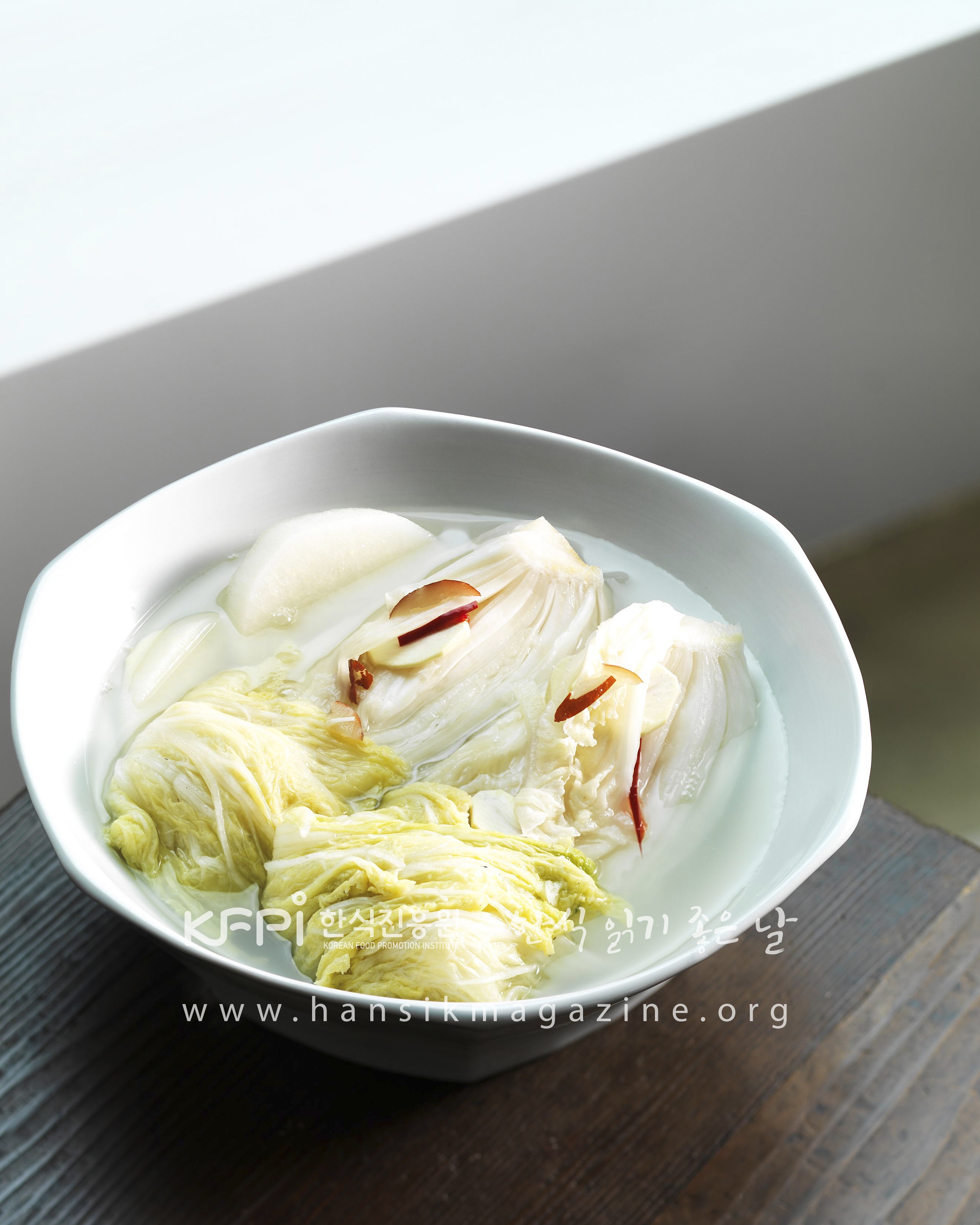
Baekkimchi(White Kimchi) © Hansik Portal
Kimchi is made of various raw and minor materials not sterilized such as cabbage, chilly pepper, garlic and salted fish. The fermentation of Kimchi starts with the action of enzyme in the cells of cabbage and radish, at that time, the sugars or amino acid from enzyme action are the feed of various microorganisms originated from ingredients, natural fermentation starts by the interaction of these microorganisms. In the early stage of fermentation, aerobic or anaerobic endothelial bacteria usually grow due to the salt concentration in kimchi. In addition, the fermentation environment is changed to low pH and anaerobic conditions, such as the generation of organic acids such as lactic acid and carbon gas. Accordingly, acid-resistant and anaerobic bacteria dominate the kimchi fermentation. Therefore, the microflora of kimchi in each fermentation stage is constantly changing. Among them, lactobacillus grows rapidly, and the acid produced by lactobacillus gradually kills other microorganisms and only the salting-resistant lactobacillus survives. Lactobacillus genus and Leuconostoc genus, Weissella genus are the most widely known lactobacillus, which is reported to directly affect kimchi fermentation so far, and other than this, there are also more than 200 kinds of microorganisms separated from kimchi, including lactobacillus.
Even if kimchi is made with the same recipe, the taste varies depending the time of making. This is because the lactobacillus directly involved in kimchi fermentation vary depending on the kinds of raw material, production time, and fermentation conditions(salinity, anaerobic conditions, fermentation temperature and fermentation period), it shows differences in fermentation metabolites(sugars, amino acids, organic acids, fragrance components, etc.) depending on the type of lactobacillus. This has a correlation with the taste of kimchi. That is, the pattern of succession of microorganism groups according to the fermentation process and cluster development are important factors that determine kimchi quality.
It has been reported that the reason why winter kimchi makes a fresh and deep taste during the season of making kimchi is because there are many leuconostoc genus, which is heterofermentative lactic acid bacteria, among the lactobacillus when fermented at low temperatures. Lactobacillus in leuconostoc genus, starts growing from the early stages of fermentation and produces carbon dioxide, lactic acid, herbic acid, ethanol and other volatile metabolites, fermenting kimchi so that it has a complex and unique flavor. In addition, the carbon dioxide produced keeps the inside of kimchi in anaerobic condition, which strongly suppresses the reproduction of aerobic bacteria to ensure a normal kimchi fermentation.
In the middle of fermentation, the number of lactobacillus in Leuconostoc genus, rapidly decreases, and as the lactobacillus of the Lactobacillus genus, which are homofermentative lactic acid bacteria, grow vigorously, kimchi becomes very sour. Since most lactobacillus in the Leuconostoc genus produce a large amount of lactic acid and can grow in an acidic environment with a pH of 3.0, the growth of the lactobacillus of the Leukonostock genus, which are relatively weak to acid, decreases at the end of fermentation of kimchi. Therefore, from the end of fermentation of kimchi, the growth of lactobacillus of the genus Leukonostock, a strain that is relatively weak to acid, decreases, while many of sourness causative bacteria reproduces. Accordingly, the fresh and deep taste of kimchi disappears. In addition, due to the proliferation of acid membrane yeast, kimchi has unpleasant smell(nasty smell) and softening(mushy) phenomenon.
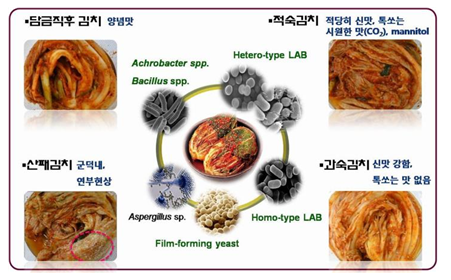
[Figure 1] Changes in microorganism and taste according to Kimchi Fermentation Process
ⓒ World Institute of Kimchi
Factors that affect Kimchi fermentation
The microorganism proliferates or disappears when governed by the fermentation environment. Therefore, the size of microorganism cluster and the variety of genus and species change by the environmental factor, and the quantity of microorganism changes dynamically.
The environmental factors that limit the growth of microorganism include physical and chemical factors. The physical factors include temperature, oxygen, oxidation-reduction potential and press while the chemical factors include the concentration of salt, the type and the mixing ratio of raw ingredients(in particular spice) and Bacteriocin. Among them, the most important environmental factors are 3 of the concentration of salt, the type and the mixing ratio of raw and minor ingredient, and the temperature and the concentration of salt is the most important environmental factor under the same ingredient mixing.
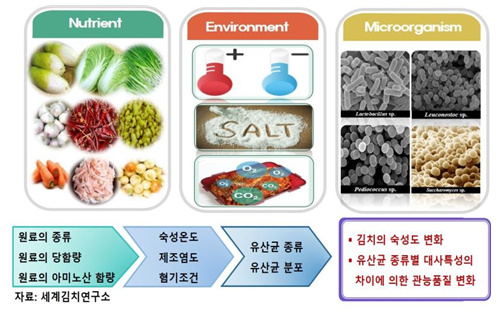
[Figure 2] Factors that affect Kimchi fermentation │ ⓒ World Institute of Kimchi
The reason why winter Kimchi is tasty
The taste of kimchi depends on raw and minor ingredients, fermentation conditions, and microorganism, which is involved in kimchi fermentation. The growth environment of raw and minor materials such as production areas and seasons may affect sensual properties such as flavor and texture because vegetables produced in other seasons have different content of water, minerals and other nutritional compounds.
In particular, cabbage, the main ingredient of baechukimchi that Koreans eat the most, is known to have differences in not only flavor, texture but also quality preservation period depending on the season when it is grown. Cabbage varieties harvested in autumn and winter are juicy and tender, and are good for eating during the winter because they contain more protein, lipid, and organic acids, but it is reported hard-tissue and low-watering varieties are better stored by suppressing softness and acidification in order to eat them in spring,
Salt was used as a method for the long term storage of baechukimchi. In kimchi, salt plays a role to reduce moisture by osmotic pressure, soften the cabbage tissue, suppress the proliferation of harmful microorganisms, and inhibit kimchi fermentation. Seasonal cabbage ingredients and salts have a significant correlation with microorganism clusters in kimchi, but it is not clear how these changes affect microorganism clusters as an important variable during kimchi fermentation.
Accordingly, the World Institute of Kimchi collects 66 kinds of baechukimchi(198 kimchi samples) manufactured by 22 kimchi companies across the country with the same raw and minor materials, recipes, and methods of manufacture, and specified the correlation between the properties of microorganism cluster and the variety depending on the regions, seasons(spring: March to May, summer: June to August, fall September to November, winter December to February, and summer kimchi are excluded due to the fermentation during distribution process), salinity, and fermentation. As a result of research, even kimchi made by the same company had different kimchi salinity depending on the season. The season with the highest kimchi salinity is autumn, and the lowest season was winter. This is interpreted that's because the main material, cabbage, is affected by the quality difference and the distribution temperature depending on the season produced. The kimchi produced in autumn is manufactured using cabbage harvested in summer and autumn, and has a higher moisture content than cabbage harvested in winter. Also, because the temperature of the distribution environment of the kimchi is high, the kimchi fermentation is controlled by adding a relatively high content of salt than winter, resulting in suppressing the proliferation of microorganism.
The type and dominant ratio of major fermented lactobacillus also changed depending on the difference in kimchi salinity. Top 3 lactobacillus, which leads kimchi fermentation, are Leuconostoc, Weissella and Lactobacillus. In this study, Weissella and Lactobacillus lactic acid bacteria showed a higher dominant ratio in spring and fall than in winter while Leuconostoc lactic acid bacteria showed a higher dominant ratio in winter than in spring and fall(Figure 5). Weissella lactic acid bacteria and Lactobacillus lactic acid bacteria enhance the sour taste of kimchi, while Leuconostoc lactic acid bacteria gives it a moderate sour, fresh sweetness and a sparkling freshness, that's why "the taste of winter kimchi is better than spring and summer kimchi."

[Figure 3] Season specific Kimchi salinity│ⓒ World Institute of Kimchi
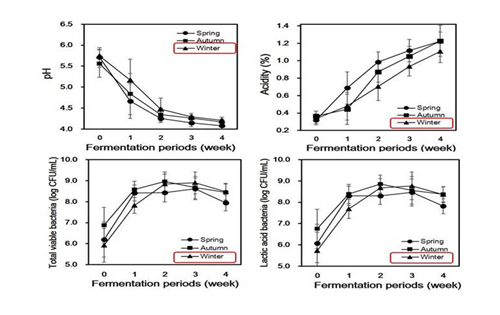
[Figure 4] Seasonal chemical(pH, acidity), microbiological property change│ ⓒ World Institute of Kimchi
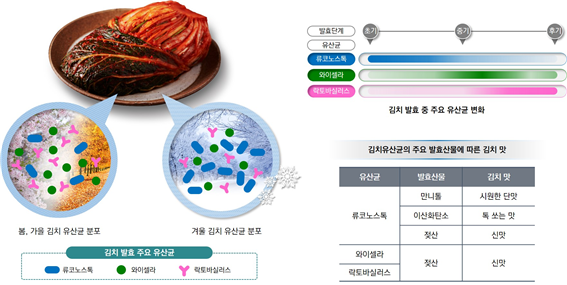
[Figure 5] Major fermentation lactic acid bacteria of seasonal kimchi and correlation of Kimchi taste
ⓒ World Institute of Kimchi

 한국어
한국어
 English
English






